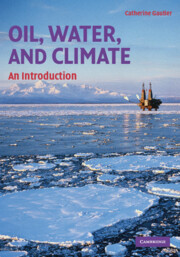Book contents
- Frontmatter
- Contents
- Foreword
- Introduction
- 1 Overview
- 2 Carbon Dioxide Emissions, Global Warming, and Water Resources
- 3 Population, Environmental Impacts, and Climate Change
- 4 Carbon Cycle and the Human Impact
- 5 Peak Oil, Energy, Water, and Climate
- 6 Oil Consumption and CO2 Emissions from Transportation
- 7 Oil, Economy, Power, and Conflicts
- 8 Energy Alternatives and Their Connection to Water and Climate
- 9 The Water Cycle and Global Warming
- 10 Fresh Water Availability, Sanitation Deficit, and Water Usage: Connection to Energy and Global Warming
- 11 Rivers, Lakes, Aquifers, and Dams: Relation to Energy and Climate
- 12 Water Contamination, Energy, and Climate
- 13 Geopolitics of Water and the International Situation
- 14 Water Alternatives
- 15 Global Climate Change: Observations, Modeling, and Predictions
- 16 Energy and Water Challenges and Solutions in a Changing Climate Framework: Commonality, Differences, and Connections
- References
- Index
13 - Geopolitics of Water and the International Situation
Published online by Cambridge University Press: 05 September 2012
- Frontmatter
- Contents
- Foreword
- Introduction
- 1 Overview
- 2 Carbon Dioxide Emissions, Global Warming, and Water Resources
- 3 Population, Environmental Impacts, and Climate Change
- 4 Carbon Cycle and the Human Impact
- 5 Peak Oil, Energy, Water, and Climate
- 6 Oil Consumption and CO2 Emissions from Transportation
- 7 Oil, Economy, Power, and Conflicts
- 8 Energy Alternatives and Their Connection to Water and Climate
- 9 The Water Cycle and Global Warming
- 10 Fresh Water Availability, Sanitation Deficit, and Water Usage: Connection to Energy and Global Warming
- 11 Rivers, Lakes, Aquifers, and Dams: Relation to Energy and Climate
- 12 Water Contamination, Energy, and Climate
- 13 Geopolitics of Water and the International Situation
- 14 Water Alternatives
- 15 Global Climate Change: Observations, Modeling, and Predictions
- 16 Energy and Water Challenges and Solutions in a Changing Climate Framework: Commonality, Differences, and Connections
- References
- Index
Summary
Water is a potential source of conflicts, but also offers a potential for cooperation in the management of shared resources. The balance between development and environmental protection is often difficult to maintain, and international agencies and nongovernmental organizations (NGOs) play an important role in maintaining that balance. There is a growing opposition to large and all-encompassing water initiatives mostly due to their inequitable impacts. Water security is a major issue as is water access, which should probably be treated as a human right.
Introduction
By 2025, the rate of water withdrawal for most uses (agriculture, domestic, and industrial) is projected to increase by at least 50% from 2000 (Rosegrant, Cal, and Cline, 2002). By 2100, without worldwide improvement in the management of this limited resource, almost all potentially available surface water will have to be used consumptively for some human need. At this predicted high rate of withdrawal, essential irrigation requirements would be severely curtailed, thus constraining global food production. Needless to say, the control of water resources and rivers has the potential to trigger conflicts between neighboring countries.
Although nations around the world are currently dividing available water resources peacefully, they are ill prepared to share this resource fairly in the future. Water allocation agreements, where they exist at all, are often many decades old and were concluded in times of relative water abundance. Conflicts may arise between countries and between different users within one country, such as between the hydropower, irrigation, fishing, and recreation industries.
- Type
- Chapter
- Information
- Oil, Water, and ClimateAn Introduction, pp. 245 - 269Publisher: Cambridge University PressPrint publication year: 2008



